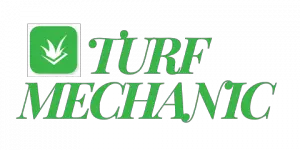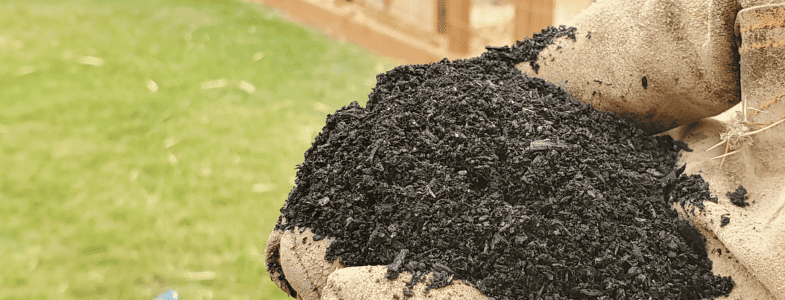Biochar is a product that is produced through pyrolysis, the burning of organic biomass under great heat but in an oxygen-free environment. Instead of biomass incinerating and turning to charcoal or ash the molecular makeup of the source material is transformed into biochar, a stable mass of carbon that is porous at the microscopic level.
The reason we want to apply biochar to soils in the garden or the lawn have everything to do with the carbon component and it’s formation.
Stable soil carbon is incredibly important to increasing the quantity and quality of soil microbiology. The pores provide safe stable environments for bacteria and mycorrhizal fungi to call home and they can hold moisture and nutrients for much longer than soils devoid of biochar can.
Quick Recommendation – The biochar I’m currently using and recommending to both the readers here and my viewers on the YouTube channel is Anderson’s BioChar DG, designed specifically for lawns. The bag contains 85% biochar and packaged for easy spreading with standard lawn spreaders. You can buy BioChar DG here. That stuff can’t be delivered to CA or OR though so if you live in those states then go with Wakefield’s biochar on Amazon. They only come in 2 lb bags so you’d need to buy a few bags for every 1000 sqft.
When biochar is present in the root zone of our lawns or our garden plants, they will need less water and will be able to hold nutrients better resulting in lower fertilization requirements.
On an environmental scale the carbon sequestration benefits of biochar are notably it’s best benefit of them all. Instead of plant material dying and releasing carbon back into the atmosphere as CO2 the carbon can be “trapped” in the biochar and left in the ground for generations where it belongs.
I could go into greater detail on BioChar’s benefits and uses but instead of recreating the wheel I recommend you read this phd level paper on biochar to grasp it’s immense benefits. The paper took me over an hour to fully read the first time through – it’s high level!
► https://www.ncbi.nlm.nih.gov/pmc/articles/PMC5426627/
► Click here to jump to my recommendations for garden use.
What BioChar is Best For The Lawn & Garden?
I’m currently testing five different biochars for the lawn and I have two or three more on my short list for experimentation.
Most biochars are designed for gardening first but in lawn care biochar comes into play when we core aerate because we can easily get the material into the root zone of our grass through the cores that we pull.
Some biochars will spread better than others, some will increase CEC better than others and others will provide long term stable Carbon in the root zone of our lawns that will help with moisture retention, limit nutrient leeching, and provide “housing” for the microscopic organisms and mycorrhizal fungi to live.
If you are looking to add biochar to your lawn or to your garden this page should help a lot. I care a lot about my lawn and we grow a ton of food in our garden beds every year. My soil system matters to me.
Let’s first look briefly at the biochars I’m testing initially.
- Wakefield (available on Amazon)
- Plant Willow (No longer available)
- Anderson’s BioChar DG (available on Amazon)
- Aries Green BioChar (available on Amazon)
- Soil Sunrise (No longer available)
UPDATE for 2025
A new biochar highly suitable for lawn use:
- FOOP Organic Inoculated BioChar (available on Amazon)
Each of these will get a section on this page devoted to them in the near future along with a few others.
I’m going to say a bit about each of these and a few of the additional biochar soil/fertilizer blends on my radar but you can start by watching my first application video on these five which I’ve embedded below.
In addition to these products I’m excited to give Yard Mastery’s Biocharcken product very soon as it’s basically a biochar that’s meant to be spread on the lawn and it’s already charged with the fertilization benefits of chicken poo “tea”. For gradual addition of biochar to the lawn while also applying slow nitrogen at the same time this seems hard to beat.
UPDATE – Biocharcken is no longer for sale as far as I know. A good alternative to it is Sol Mastery which is nearly 40% coconut husk biochar with a touch of fertilizer included in the bag. See it here.
Also I’ll be looking into Wakefield’s Compost HERO Biochar blend as it contains 20% biochar mixed with premium compost infused with mycorrhiza…seriously this stuff looks so good. I may just buy a few yards of this stuff to do light lawn leveling after core aeration because it looks that good and because they sell it by the yard in bulk on their website.
You can see the 1 cft bag of HERO biochar blend through this Amazon affiliate link or the two cubic yard option through the Wakefield website here.
As I find more product options I’ll be adding them to this page. I’ll also be adding links to other biochar articles here as I write them and publish them.
Which BioChar Would I Pick For Gardeners?
The main audience for Turf mechanic are lawn care enthusiast but the products we use to maximize our lawns frequently cross paths with avid gardeners; but the application rates and methods of delivery differ greatly in many cases.
For the lawn I really like the Aries product for easy spreadability and for it’s ability to slowly incorporate into the soil over time but for use in the garden I would buy the Willow biochar product over-and-over-and-over again for it’s quality and purity.
The consistency is so fine that it will incorporate into any soil or potting mix effortlessly and will charge very easily inside the soil due to it’s enormous amount of surface area.
Willow’s BioChar (renamed Rosy Biochar Booster) is one of the pricier products by cubic foot but it’s the product my wife and I will use in our garden for the foreseeable future.
Click here to check pricing and availability.
Last parting thought: if you are looking into biochar and haven’t added humic acids into your soil building efforts then see this post on the site where I explain what humic acid is and what it does.

